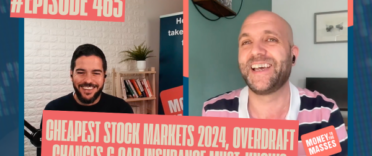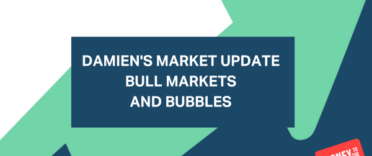The 121st episode of my weekly YouTube show where I discuss what is happening in investment markets and what to look out for. This week I talk about how inflation has been affecting markets in both the UK and the US.
Each show lasts between 5-10 minutes and is aimed at DIY investors (including novices) seeking contemporary analysis to help them understand how investment markets work.
Subscribe to my YouTube channel to receive my weekly analysis of investment markets or alternatively, you can listen via my weekly Midweek Markets podcast below.
Midweek Markets weekly podcast
Other ways to watch, listen and subscribe
You can listen to other episodes and subscribe to the show by searching 'Money to the Masses' on Spotify or by using the following links:
Abridged transcript - Midweek Markets episode 121
Inflation inflation inflation…. That’s all that’s been on investors' minds this week. Let’s start in the UK where the Office of National Statistics today announced that inflation had risen to 3.2% in the year to August, up from 2% the previous month.
Although the ONS warned not to read too much into the rise, citing it as a temporary increase, it is the biggest jump in prices since records began in 1997. It is also the highest inflation reading since 2012, when inflation as measured by CPI hit 3.5%, but back then inflation was on the way down.
Despite the surge in inflation UK gilt yields barely moved. Logically you may expect yields to rise alongside the expectation that the Bank of England (BOE) may have to raise interest rates sooner rather than later to quell inflation if it becomes ingrained. It suggests that the market is buying the “temporary inflation” narrative in the UK, but not only that the Bank of England had previously warned of a temporary spike in inflation, as 4%, in the latter stages of this year.
The impact on equity markets can be seen already. The FTSE 250 fell around 1% after the inflation news broke, yet still sits only 3% below it’s all time high.
Interestingly just a day earlier, and across the pond, inflation data in the US surprised to the downside. Headline US consumer prices rose by 5.3% in the year to August, which slightly undershot economist expectations of 5.4%. The surprise miss saw the 10 year US treasury yield capitulate and fall from 1.3% to as low as 1.265% on Tuesday.
The narrative was that with inflation possibly cooling, reducing the pressure on the US Federal Reserve to raise interest rates or cut its bond buying QE programme before the year end. Bonds were therefore bought, yields collapsed and equity markets began rotating again in favour of the stagflationary trades.
Indeed recent economic data in the UK showed that economic growth disappointed as a result of the pingdemic over the summer, while the Chinese data showed that its economic slowdown has worsened as a result of August's coronavirus outbreaks. Indeed, the impact of COVID tends to show up sooner rather than later in Chinese economic data due to the swift and aggressive crackdown measures that its government enforces whenever there is an outbreak. In the west the impact and recovery from a pandemic control measure is typically much slower to become evident in economic data.
But it means that the market position turned back towards one preparing for stagflation. So the usual suspects such as tech stocks, REITs and utilities outperformed energy stocks and financials. Gold broke back above $1,800 per oz.
The 10 year US treasury yield has since rebounded to 1.29%, but for now sits below that key level of 1.3% and calls into question the recent short-term trend of rising interest rates. Similarly, unless the yield falls below 1.26%-1.27% the six month downtrend in yields has also been broken, for now. It seems that the bond markets are looking for direction, with participants clueless as to the future path of inflation and central bank monetary policy, particularly from the Fed.
However last week the ECB did play its hand and reduced its QE programme but went to great lengths to say it was a recalibration and not tapering. The can on tapering was kicked down the road until December, but it means that the market was appeased even though the starting gun was fired on monetary tightening on the continent. In fact European stocks are up this week, albeit between 0.2% and 1%.
UK stocks (be it the FTSE 100 or 250) were replicating the same moves until the new inflation figures were published. It seems that bond and equity markets prefer certainty (especially when it comes to monetary policy) and with the BOE and the Fed this is missing at present.
It will be interesting to see how the UK inflation reading impacts the market’s predictions of when the BOE will raise interest rates. The day before, the yield curve was pricing in a rate rise to 0.25% by the end of the 1st half of 2022. How this will change we will have to wait and see over the coming days.
Bond and equity markets are messy at present with participants trying to second guess central banks and the future path of inflation and economic growth. This is starting to take its toll in US equities where for five straight days they ground lower before some repiste. For example the S&P 500 is down 1.4% over the last week, compared to the 1% gain in the German DAX. Such divergences between the two are unusual and something to keep an eye on because normally one, way or another something usually gives.
But UK and US markets will likely gain more certainty next week when the Bank of England and the Fed’s policy meetings occur on the 23rd and 22nd of September respectively. Things could get interesting.



